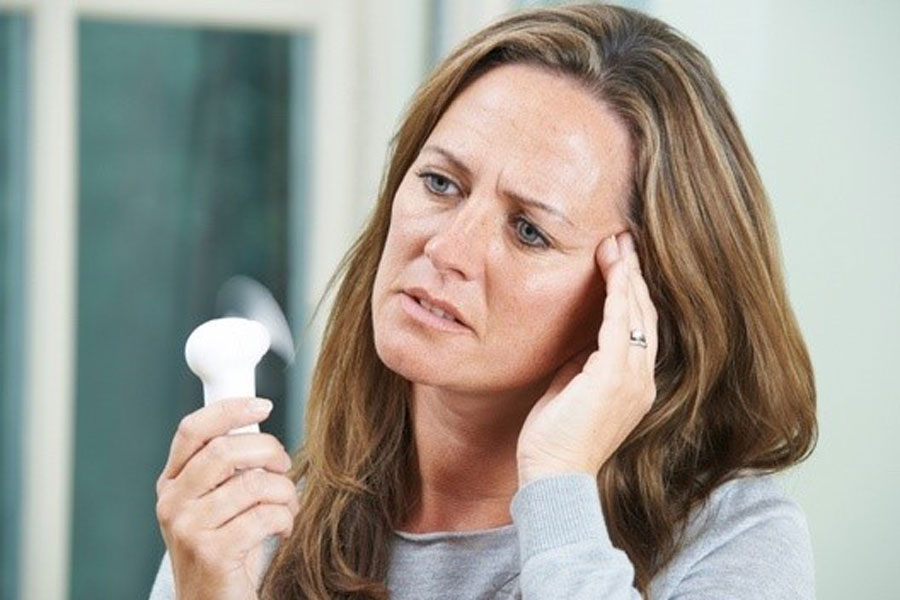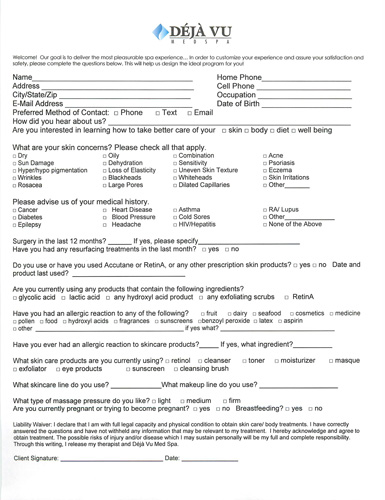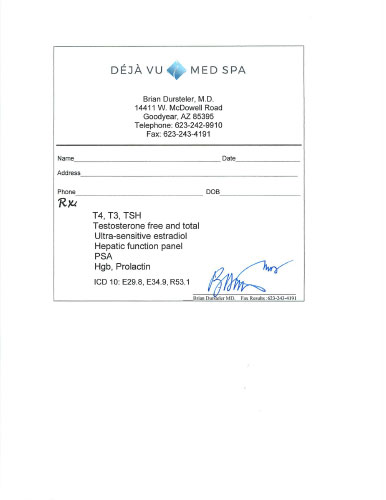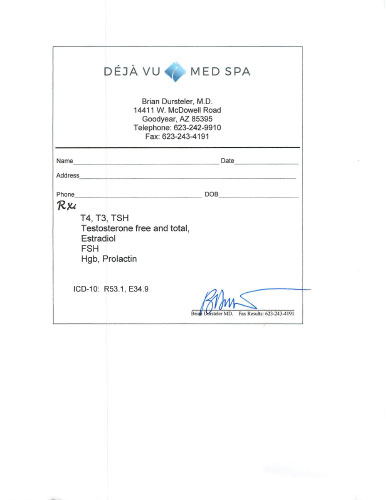
Do you feel less alive than you did ten years ago? As we age, our hormone levels decline and can lead to symptoms such as fatigue, insomnia, poor concentration, loss of libido, loss of muscle mass, and weight gain. You no longer need to live this way. Bioidentical hormone replacement therapy (BHRT) replenishes the exact hormones our bodies need to function properly using customized pellets that are placed under the skin for a steady state of hormones. This treatment is for both men and women and is a game-changer for improving your quality of life.
Success Stories
I met with Dr. Brian Dursteler for hormone replacement. His knowledge of hormone replacement is considerable, his technique painless I find Dr. Dursteler to be an excellent physician.
— Carol E.
Request an appointment today!
At Deja Vu Med Spa, we make it convenient to plan your visit. Click the link to request an appointment that fits your busy schedule. We can't wait to see you.
Questions?
Read our frequently asked questions below to see if you can find the answer you're looking for!
Pellets are made up of either estradiol or testosterone. The hormones are pressed or fused into very small solid cylinders. These pellets are larger than a grain of rice and smaller than a ‘Tic Tac’. In the United States, the majority of pellets are made by compounding pharmacists and delivered in sterile packaging. There is an ‘FDA approved’ 75 mg testosterone pellet. Deja Vu Med Spa only uses Testerone pellets.
Pellets deliver consistent, healthy levels of hormones for 3-5 months in women and 4-6 months in men. They avoid the fluctuations, or ups and downs, of hormone levels seen with every other method of delivery. This is important for optimal health and disease prevention. Pellets do not increase the risk of blood clots like conventional or synthetic hormone replacement therapy.
In studies, when compared to conventional hormone replacement therapy, pellets have been shown to be superior for relief of menopausal symptoms, maintenance of bone density, restoration of sleep patterns, and improvement in sex drive, libido, sexual response, and performance.
Testosterone delivered by a pellet implant has been used to treat migraine and menstrual headaches. It also helps with vaginal dryness, incontinence, urinary urgency, and frequency. In both men and women, testosterone has been shown to increase energy, relieve depression, increase the sense of well being, relieve anxiety and improve memory and concentration. Testosterone increases lean body mass (muscle strength, bone density) and decreases fat mass. Men and women need adequate levels of testosterone for optimal mental and physical health and for the prevention of chronic illnesses like Alzheimer’s and Parkinson’s disease, which are associated with low testosterone levels.
Even patients who have failed other types of hormone therapy have a very high success rate with pellets. There is no other ‘method of hormone delivery’ that is as convenient for the patient as the implants. Pellets have been used in both men and women since the late 1930’s. There is more data to support the use of pellets than any other method of delivery of hormones.
The insertion of pellets is a simple, relatively painless procedure done under local anesthesia. The pellets are usually inserted in the lower abdominal wall or upper buttocks through a small incision, which is then taped closed. The experience of the health care professional matters a great deal, not only in placing the pellets but also in determining the correct dosage of hormones to be used.
Complications from the insertion of pellets include; minor bleeding or bruising, discoloration of the skin, infection, and the possible extrusion of the pellet. Other than slight bruising, or discoloration of the skin, these complications are very rare. Testosterone may cause a slight increase in facial hair in some women. Testosterone stimulates the bone marrow and increases the production of red blood cells. A low testosterone level in older men is a cause of anemia. Testosterone, delivered by implants or other methods, can cause an elevation in the red blood cells. If the hemoglobin and hematocrit (blood count) get too high, a unit of blood may be donated.
Hormone deficiency is a common cause of hair loss and treatment with testosterone implants can help to re-grow hair. Hair becomes thicker and less dry with pellet therapy.
Check out ways to improve hair growth under the PRP Hair Restoration page
Some patients begin to ‘feel better’ within 24-48 hours while others may take a week or two to notice a difference. Diet and lifestyle, along with hormone balance are critical for optimal health. Stress is a major contributor to hormone imbalance and illness.
The pellets usually last between 3 and 5 months in women and 4-6 months in men. The pellets do not need to be removed. They completely dissolve on their own.
Progesterone can be used as a vaginal cream during pellet therapy for vaginal dryness. If a patient is pre-menopausal, she uses the progesterone the last two weeks of the menstrual cycle (day 1, the first day of bleeding). Hormone therapy with pellets is not just used for menopause. Women at any age may experience hormone imbalance. Levels decline or fluctuate contributing to debilitating symptoms. Pellets are useful in severe PMS, postpartum depression, menstrual or migraine headaches, and sleeping disorders. Pellets may also be used to treat hormone deficiencies (testosterone) caused by the birth control pill.
After the insertion of the implants, vigorous physical activity is avoided for 48 hours in women and up to 5 to 7 days in men. Early physical activity is a cause of ‘extrusion’, which is a pellet working it’s way out. Antibiotics may be prescribed if a patient is diabetic or has had a joint replaced. However, this is a ‘clean procedure’ and antibiotics may not be needed.
You may wonder why you haven’t heard of pellets. Pellets are not patented and have not been marketed in the United States. They are frequently used in Europe and Australia where pharmaceutical companies produce pellets. Most of the research on pellets is out of Europe and Australia. Pellets were frequently used in the United States from about 1940 through the late ’70s when oral patented estrogens were marketed to the public. In fact, some of the most exciting data on hormone implants in breast cancer patients is out of the United States. Even in the United States, there are clinics that specialize in the use of pellets for hormone therapy.
Testosterone levels begin to decline in men beginning in their early '30’s. Most men maintain adequate levels of testosterone into their mid-'40’s to mid-’50s, some into their late '70s to early ’80s. Men should be tested when they begin to show signs of testosterone deficiency. Even men in their '30’s can be testosterone deficient and show signs of bone loss, fatigue, depression, dysfunction, difficulty sleeping, and mental decline. Most men need to be tested around 50 years of age. It is never too late to benefit from hormone therapy.
He or she is wrong. There is a big difference between ‘no data’ and not having read the data. It is much easier for busy practitioners to dismiss the patient than it is to question their beliefs and do the research. It’s about a patient making an informed choice. After pellets are inserted, patients may notice that they have more energy, sleep better and feel happier. Muscle mass and bone density will increase while fatty tissue decreases. Patients may notice increased strength, coordination and physical performance. They may see an improvement in skin tone and hair texture. Concentration and memory may improve as will overall physical and sexual health. There is data to support the ‘long term’ safety of hormones delivered by pellet implants.
Pellets do not carry with them the same risk of breast cancer as high doses of oral estrogens that do not maintain the correct estrogen ratio or hormone metabolites. Nor, do they increase the risk of breast cancer like the synthetic, chemical progestins used in the Women’s Health Initiative Trial. Data supports that balanced, bio-identical hormones are breast protective.
Testosterone, delivered by pellet implantation, has been shown to decrease breast proliferation and lower the risk of breast cancer, even in patients on conventional hormone replacement therapy. Clinical studies show that bio-identical testosterone balances estrogen and is breast protective. This is not true of oral, synthetic methyl-testosterone found in Estratest ®, which gets converted to a potent synthetic estrogen, which can stimulate breast tissue. In the past, testosterone implants have been used to treat patients with advanced breast cancer. In 1940, it was theorized that treating patients with testosterone implants earlier, at the time of diagnosis, would have an even greater benefit, preventing a recurrence. Androgens have also been shown to enhance the effect of Tamoxifen® therapy in breast cancer patients. References supporting these statements can be found in the data section of the website in the ‘Breast Cancer Folder’. A powerpoint presentation ‘Nov 07′, summarizing the full-text references, may be viewed.
Although some physicians and pharmaceutical companies claim that, ‘bio-identical hormones are not safer than synthetic, chemical hormones’, this is not true. Bio-identical progesterone (including FDA approved Prometrium®) does not increase the risk of breast cancer like synthetic progestins. Progesterone, used vaginally, does not negate the beneficial effects of estrogen on the heart like the synthetic progestins. Estriol, an estrogen widely used in Europe is a bio-identical hormone, which has never been submitted for FDA approval in the United States. It does not bind strongly to estrogen receptors and does not stimulate breast tissue. Numerous studies have shown that vaginal estriol does not increase the risk of breast cancer (RR 0.7). It has safely been used in breast cancer survivors where it lowered the risk of recurrence and death. It is important to understand that balanced hormones are the key to health and disease prevention. There are FDA approved bio-identical hormones like Prometrium®, estradiol gels and patches, and the testosterone pellet. FDA approval is only required if a pharmaceutical company wants to market a drug to the public.
Hormone levels will be drawn and assessed before therapy is started. This will include an FSH, estradiol, testosterone and free testosterone for women. Thyroid hormone levels may also be measured. Men need a PSA, sensitive estradiol, testosterone, liver profile and blood count prior to starting therapy. Levels will be rechecked during hormone therapy, usually prior to insertion of the next set of pellets, 4-5 months. After the first year of therapy, hormones levels may be followed less frequently. Men must notify their primary care physician and obtain a digital rectal exam each year. Women are advised to continue their monthly self-breast exam and obtain a mammogram and/or pap smear as advised by their gynecologist or primary care physician.
The cost for the insertion of pellets is between $230 and $600 depending on the dose of the hormone and the number of pellets needed. Men need a much larger dose of testosterone than women and the cost is higher. Pellets need to be inserted 2 to 4 times a year depending on how rapidly a patient metabolizes hormones.
When compared to the cost of drugs to treat the individual symptoms of hormone decline, pellets are very cost-effective. There is more good, ‘unbiased’ data on pellets and bone density than any pharmaceutical drug on the market. It is beyond the scope of this handout to examine the cost of drugs used for insomnia, depression, sexual dysfunction, obesity, diabetes, hypertension and more.
Some insurance companies cover the cost of pellets, especially in men. Others do not. Most physicians require payment for their services. Patients may want to contact their insurance companies to see if their costs will be reimbursed. Prevention is much more cost-effective than a disease.
Testosterone pellets may be used in pre-menopausal females (women who have not stopped menstruating). Testosterone has been shown to; relieve migraine or menstrual headaches, help with symptoms of PMS (premenstrual syndrome), relieve anxiety and depression, and improve sex drive and libido. If a pre-menopausal female has a testosterone pellet inserted, she must use birth control. There is a theoretical risk of ‘masculinizing’ a female fetus (giving male traits to a female fetus).
In conclusion, testosterone therapy by implantation of pellets is a safe and effective method of hormone therapy for both men and women. Long, continuous administration of hormones by pellets is convenient and economical for the patient. Pellet implantation has consistently proven more effective than oral, intramuscular, and topical hormone therapy with regard to bone density, sexual function, mood and cognitive function, urinary and vaginal complaints, breast health, lipid profiles, hormone ratios, and metabolites.







